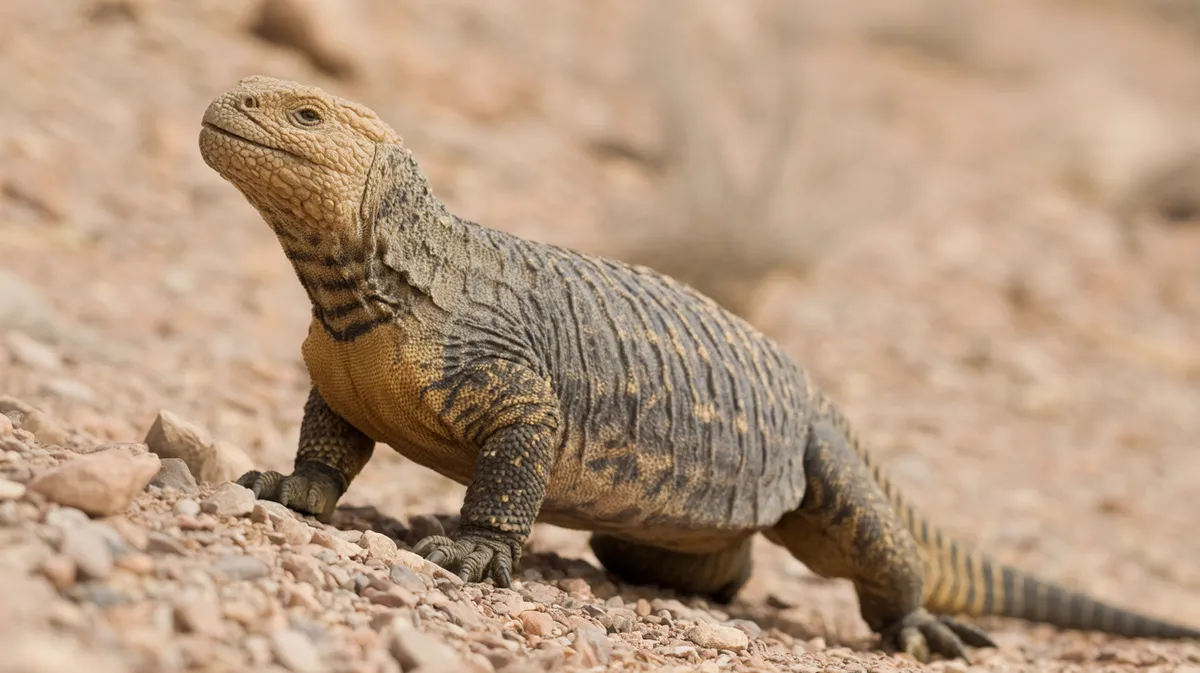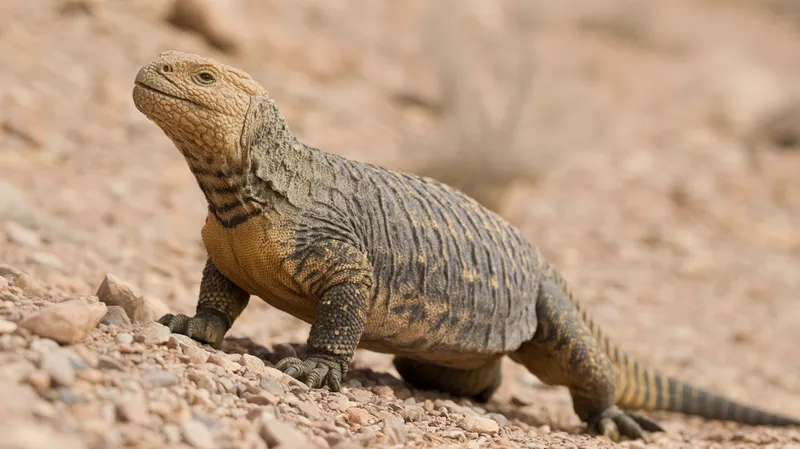
Ornate Uromastyx
Uromastyx ornata

Meet the Ornate Uromastyx
The Ornate Uromastyx is a striking species of spiny-tailed lizard known for its vibrant coloration and intricate patterns. Native to arid rocky deserts of the Middle East, this reptile is well-adapted to hot, dry environments. Its body is robust, with a distinctive, spiked tail used for defense against predators. The Ornate Uromastyx is primarily herbivorous and is diurnal, basking in the sun during the day and sheltering in burrows at night.
Classification
Reptile
Habitat
Arid rocky desert
Diet
Herbivore
Lifespan
15-20 years
Conservation
Near Threatened
Weight
250-400 grams
📖Fascinating Facts
Desert Specialist
The Ornate Uromastyx thrives in harsh, rocky deserts where temperatures can exceed 40°C (104°F).
Colorful Displays
Males are especially colorful, displaying vibrant greens, blues, and yellows to attract mates and deter rivals.
Plant Eater
Their strong jaws and teeth allow them to eat tough, fibrous desert vegetation that many other animals avoid.
📋Detailed Description
The Ornate Uromastyx (Uromastyx ornata) is a medium-sized agamid lizard, typically reaching a snout-to-vent length of 25–30 cm, with the tail comprising an additional 15–20 cm. Its body is robust and dorsoventrally flattened, an adaptation for squeezing into narrow rock crevices. The species is renowned for its vivid coloration: males display brilliant green, turquoise, or yellow hues with intricate reticulated patterns, while females are generally more subdued in coloration, often brownish or olive with less pronounced markings. The tail is heavily armored with 20–23 whorls of spiny, keratinized scales, serving as a formidable defense mechanism. The head is short and blunt, with powerful jaws adapted for crushing tough plant matter. Uromastyx ornata is diurnal and highly heliothermic, relying on basking to regulate its body temperature, which can reach up to 40°C during peak activity. This species is primarily solitary, occupying overlapping home ranges but rarely interacting outside of the breeding season. It excavates or utilizes existing burrows in rocky substrates, which provide refuge from predators and extreme temperatures. The Ornate Uromastyx exhibits seasonal activity patterns, with periods of aestivation during the hottest months and reduced activity in winter.
💡 Did you know?
Despite living in extreme heat, the Ornate Uromastyx rarely drinks water, obtaining nearly all its moisture from its plant-based diet.
🔬Research & Sources
🎭Behavior & Social Structure
Ornate Uromastyx are primarily herbivorous, feeding on a wide variety of desert vegetation including leaves, flowers, seeds, and occasionally fruits; they have been observed consuming insects opportunistically, particularly juveniles. Foraging occurs during the cooler morning and late afternoon hours, with extended basking sessions in between. They are territorial, especially males, who may display aggressive posturing, tail-lashing, and head-bobbing to deter rivals. Social interactions are limited, though overlapping burrow systems may occur in areas of high population density. Daily routines are dictated by ambient temperature, with individuals emerging from burrows shortly after sunrise to bask and returning before dusk. When threatened, they retreat rapidly to their burrows, using their spiny tails to block the entrance and deter predators. Communication is primarily visual, involving body inflation, color changes, and tail displays.
👶Reproduction & Life Cycle
Breeding occurs in spring, typically from March to May, triggered by rising temperatures and increased daylight. Males engage in courtship displays involving head-bobbing, body inflation, and vivid coloration to attract females. After copulation, females lay a clutch of 5–20 eggs in a self-dug burrow or a concealed crevice, usually in late spring. Incubation lasts approximately 8–10 weeks, depending on environmental conditions, with hatchlings emerging in early to mid-summer. There is no parental care post-oviposition; hatchlings are independent from birth and must fend for themselves. Sexual maturity is reached at 3–4 years of age. Reproductive output is closely linked to environmental factors, particularly food availability and temperature.
🛡️Adaptations & Survival
Uromastyx ornata exhibits several adaptations for desert survival. Its flattened body and strong limbs allow it to navigate rocky terrain and excavate burrows. The spiny tail serves both as a defensive weapon and a tool for blocking burrow entrances. Its herbivorous diet is supported by a highly efficient digestive system, including a large cecum for fermenting fibrous plant material. The species is capable of extracting moisture from food, minimizing water loss, and excretes uric acid instead of urea to conserve water. Behavioral thermoregulation is highly developed, with precise basking and burrow use to maintain optimal body temperature. Coloration is not only for camouflage but also for social signaling and thermoregulation, as darker colors absorb more heat during cooler periods.
📚Research Sources
🎨Cultural Significance
In some Middle Eastern cultures, Uromastyx species have been referenced in folklore and traditional medicine, although U. ornata specifically is less prominent than other uromastyx species. Historically, uromastyx lizards have been used as a food source and occasionally in traditional remedies, but such practices are now rare and discouraged due to conservation concerns. The species is increasingly appreciated in the international pet trade for its striking appearance, though this has contributed to population declines in the wild.
🔬Recent Research & Discoveries
Recent research has focused on the phylogeography and genetic diversity of Uromastyx ornata populations, revealing significant genetic structuring across its range, likely due to historical geographic barriers. Studies on thermoregulation have highlighted the species' remarkable ability to tolerate high body temperatures and its reliance on behavioral adaptations for survival. Conservation-oriented research is ongoing, with efforts to develop captive breeding protocols and assess the impact of the pet trade. Ecological studies have documented the species' role as a seed disperser and its interactions with native flora. There is growing interest in the effects of climate change on its habitat suitability and reproductive success.
🎥Wildlife Videos

Dazzling Deserts: A Journey Through the Most Beautiful Desert Reptiles #reptiles #serpent #animal
Explore the Enchanting World of Desert Reptiles | Amazing Facts and Observations Prepare to be mesmerized by the stunning ...
Wild Unveiled

UROMASTYX IN THE WILD! (are we keeping them correctly?)
UROMASTYX IN THE WILD! (are we keeping them correctly?) Uromastyx lizards are one of the best pet reptiles, and one of the ...
Dāv Kaufman's Reptile Adventures

Excavating a fresh clutch of Saudi Arabian spiny-tailed lizard (Uromastyx ornata philbyi)
Every year when our mastigures make clutches we make a detailed video on what to do with the eggs if you saw the female just ...
BION Terrarium Center

My Wonderful Nancy Feeds Chunk the Uromastyx Lizard
I got an iPhone 6+ yesterday and used it to make a movie about my wife feeding our grandkids' Uromastyx Lizard, aka "Chunk".
John Thornton

The RAREST Tortoises and Uromastyx in the WORLD!
In this video we visit Mennellas Exotics and show you guys the first USCB Albino Cherry Head Tortoises! Check him out on ...
TikisGeckos

we got a UROMASTYX
this was June 4-6 2021 we got a Uromastyx named Spinelli on June 4! This is videos of her in the first couple days we got her, ...
Leah Fries
🌍Habitat Information
The Ornate Uromastyx typically inhabits Arid rocky desert environments. Ornate Uromastyxs have adapted to their environments with specialized features and behaviors.
Primary Habitat:
Arid rocky desert
More detailed habitat information will be available soon.
🛡️Conservation Status
The Ornate Uromastyx is currently classified as Near Threatened. Conservation efforts are crucial for preserving this species for future generations.
Common Threats:
- 🏠Habitat loss and fragmentation
- 🌡️Climate change impacts
- 🎯Hunting and poaching
- 🏭Human-wildlife conflict
⚠️Threats & Conservation Challenges
The primary threats to Uromastyx ornata include habitat destruction due to agricultural expansion, urbanization, and quarrying in its native range (Egypt, Israel, Jordan, Saudi Arabia, and the Sinai Peninsula). Over-collection for the international pet trade has significantly impacted wild populations, particularly in areas with poor enforcement of wildlife protection laws. Additional pressures include predation by feral animals and climate change, which may alter the availability of suitable habitat and food resources. Population trends indicate a decline in several regions, prompting its Near Threatened status on the IUCN Red List. Conservation challenges include habitat fragmentation, lack of public awareness, and insufficient legal protection in some range countries.
🔬Scientific Classification
Scientific Name
Uromastyx ornata
Classification Hierarchy
🔍 About Taxonomic Classification
Taxonomic classification is a hierarchical system used by scientists to classify and organize living organisms based on shared characteristics and evolutionary relationships.
The system moves from broad categories (Kingdom) to increasingly specific ones, with each animal's scientific name typically consisting of its Genus and species.
📝Community Notes
Share your observations and insights about the Ornate Uromastyx with our community of wildlife enthusiasts.
Join Our Community
Sign in to share your observations and connect with fellow wildlife enthusiasts.
Sign In to ContributeNo community notes yet
Be the first to share your observations about the Ornate Uromastyx!
Explore Ornate Uromastyx
Select a tab above to learn more about this amazing animal.
📸Photo Gallery
No photos available for this animal yet.
🌟Discover More Wildlife
Continue your journey of discovery with more fascinating animals from our database
